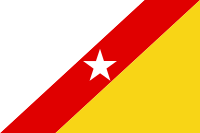National Liberation Front of Angola
|
National Liberation Front of Angola
Frente Nacional de Libertação de Angola |
|
|---|---|
| President | Ngola Kabangu |
| Founded | 1954 (as the União dos Povos do Norte de Angola guerrilla movement) 1959 (as the União dos Povos de Angola guerrilla movement) 1961 (as the FNLA guerilla movement) 1992 (as a party) |
| Headquarters | Luanda, Republic of Angola |
| Ideology |
Civic nationalism Christian democracy Conservatism |
| Political position | Centre-right |
| Seats in the National Assembly |
2 / 220
|
| Party flag | |
 |
|
| Website | |
| http://www.fnla.net/ | |
The National Front for the Liberation of Angola (Portuguese: Frente Nacional de Libertação de Angola, FNLA) was a militant organization that fought for Angolan independence from Portugal in the war of independence, under the leadership of Holden Roberto.
Founded in 1954 as the União dos Povos do Norte de Angola guerrilla movement, it was known after 1959 as the União dos Povos de Angola (UPA) guerrilla movement, and from 1961 as the FNLA guerilla movement.
Ahead of the first multiparty elections in 1992, the FNLA was reorganized as a political party. The FNLA received 2.4% of the votes and had five Members of Parliament elected. In the 2008 parliamentary election, the FNLA received 1.11% of the vote, winning three out of 220 seats.
In 1954, the United People of Northern Angola (UPNA) was formed as a separatist movement for the Bakongo tribe who wished to re-establish its 16th century feudal kingdom but was also a protest movement against forced labour. Holden Roberto was to be the king of that land. By 1958, the organisations name changed to the “Uniao das Populcoes de Angola” (UPA) under Holden Roberto who came from São Salvador, Bakongo, Northern Angola with the newly named organisation described as an ethnic political movement. In March 1961, the UPA begun an uprising in the north attacking white coffee plantation owners and servants, “assimilados”, African Catholics and tribal members other than the Bakongo tribe. The Portuguese government respond by sending soldiers to Angola and more than 50,000 people would die in the violence by the end of 1961. It was said more than a million refugees would flee the north of Angola for Zaire. In an attempt to become a national political movement, it merged with the “Partido Democratico de Angola” (PDA) to form the “Frente Nacional de Libertação de Angola” (FNLA). By February 1962, the FNLA had merged into an organisation called the Angolan Revolutionary Government in Exile (GRAE) with Roberto as its President and Jonas Savimbi as its foreign minister, based in Kinsasha, Zaire and recognised by the Organisation of African Unity (OAU) as Angola's only freedom movement until 1971. Its core membership were Angolan refugees and expatiates in Zaire.
...
Wikipedia
